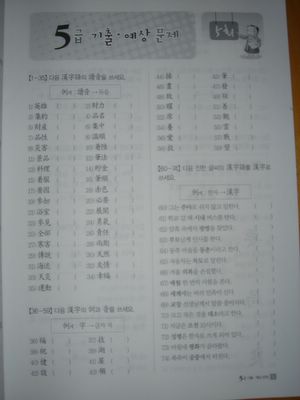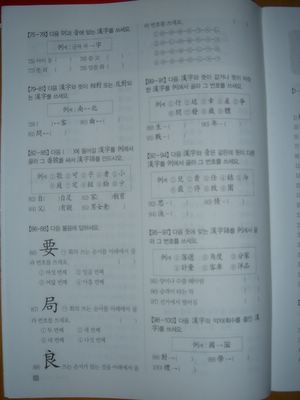漢字 5급 Practice Test
I got a lot of questions and comments regarding my upcomming 漢字 test. So here is a run down of how the test (at least the level 5 test) is breaking down.

Level 5 page 1
This page has three parts to it. Part one (questions 1-35) requires the test taker to write the Korean readings of the various Sino-Korean words. For example number 4 品名 requires the test taker to write 품명. Part two (36-59) requires the test taker to write the 뜻 (Korean meaning) and the 음 (phonetic sound) of the various character. For example number 36 requires the test taker (me) to write 복(the meaning) 복(the sound). Part three has various sentences with words bolded. The test taker is required to replace the bolded words with their 漢字 equivalent. Let's look at number 71: 지금은 오전 10시이다. (Now it is 10 o'clock in the morning.) I have to replace 오전 with 午前 and get an awesome score. On the the next page!

Level 5 page 2
Questions 75-78 require me to write the 漢字 for the given 뜻 and 음. Example 아이 동 means I gotta write 童. Questions 79-81 require me to write the opposites of the 漢字 listed. Example 客 (customer) means I gotta write 主 (master)...I have no idea that some of these things are opposite. The level 8, 7, and 6 opposites make sense, but these are getting whack. Questions 82-85 are Matt at No-sword's friend and mine the 4 character compounds. This section requires me to select the missing character from the compound from a box of various character. Example 男女老( ) I gotta chuck a 少 in there to get 男女老少 (man woman old young). 86-88 is about stroke order. What number are the various strokes made? Who cares really...this section is boring so onward! 89-91 find the characters with the same definitions. 年 (해 년) and 歲 (해 세) both have the meaning of 해. Questions 92-94 involves finding characters with different meanings but the same pronunciation (決 and 結 are both read as 결). Questions 95-97 involves matching words to definitions (승객이 타는 차 -> 客車). The final part of the test has me writing simplified (or 약자) versions of the characters listed. I don't really understand why this part of the test, since in Korea simplified characters aren't used. I know a few of them due to my semester of Japanese, but I have to do some more studying in this area. For example, I only know that 學 is simplified as 学, but that's about it. Like I said, only traditional characters are used here...so this part will kick my ass.
There you have it, a Korean 漢字 exam. How does it compare to the Japanese version of this kind of test?


<< Home